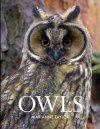"Marianne Taylor's delightful Owls is a riot of magnificent images and crisply presented text that ensures that it is a beautiful book to look at. Of course, this is aided by the subject of the publication: somehow I doubt that shots of large white-headed gulls on festering rubbish dumps would have quite the same appeal, irrespective of image quality. Photographs feature from Finnish heavyweights Arto Juvonen, Tomi Muukkonen, Jari Peltomäki and Markus Varesvuo. Ranging from outrageous close-ups of great grey owls to the bizarre capture of a pygmy owl lying face-down in the snow, the photography alone justifies the £25 price tag – as you'd expect with such an impressive quartet taking responsibility behind the lens.
But there is plenty more to the title than its photography. The first 96 pages offer a general introduction to owls as a whole, discussing just about every characteristic that makes them recognisable as well as typical life cycles, before discussing our own relationship with owls, the threat we pose and resulting conservation efforts that come about. The text is written in a simple and informative manner, making it a great book to learn from. I know for a fact that this is exactly the kind of book I would have loved as an impressionable youngster with a growing interest in birds: the sort of publication I would have spent many a post-Christmas hour poring over, lapping up the information on offer. That's not to say this is a book for kids, though; anyone would enjoy it, from those with a mere passing interest in wildlife to the most serious birder.
Having said that, let me make it clear this is not a field guide, nor is it intended to be. Don't expect to use the species accounts as a reference for comparing identification features of some of the more tricky Otus species, for example. Furthermore, given that its recent rediscovery in Turkey was arguably the most exciting ornithological news to occur within the Western Palearctic this century, I was genuinely surprised to see that the only reference to brown fish owls within the region was of a small Israeli population that 'is probably now extinct'. That said, the accounts are otherwise of genuine quality, with exquisitely presented text that bustles with information, ranging from descriptions through to status and conversation. Needless to say, each species is illustrated by at least one captivating photograph."
– Josh Jones, 22-11-2012, www.birdguides.com
"At first glance, this roughly A4-sized book may appear to be another coffee – table book on a group of birds well-known to be popular with the public but, in fact, it is much more than that. Yes, it is a stunning attractive book, with glorious large format colour photographs of owls on every page, but the concise text is well-researched and well laid out and accessible too. The first third of the book describes owls in general, including such matters as their remarkable hearing and eyesight, their hunting methods and diet, habitats and conservation.
All of this is enlivened with excellent photographs of such exotics as Blakiston's Fish Owl, Oriental Bay Owl and Spectacled Owl as well as more familiar species. The bulk of the book then consists of species accounts. These cover all the Western Palearctic and all the North American species, plus a selection of other Asian species: Eastern Grass Owl, Mountain, Oriental, Collared and Elegant Scops Owls, Blakiston's Fish Owl, Tawny Fish Owl, Himalayan Wood Owl, Brown Wood Owl, Collared Owlet, Asian Barred Owlet and Brown Hawk Owl. Although the Western Palearctic and North America are fully covered, there are thus very many species worldwide not included; this book does not attempt to compete with the impressively comprehensive world coverage of the recent Owls of the World: A Photographic Guide (Mikkola 2012). The accounts range from one to four pages per species, depending on how well-studied they are. Each is concisely described under the headings Size, Range, Evolution and Relationships, Description, Geographical variation, Movements and migration, Voice, Habitat, Behaviour, hunting and diet, Breeding and Status, and Conservation – and all accompanied by stunning photographs which are just about all well up to the best of modern standards. The only exception to this being the Marsh Owl photographs, which are all unaccountably poor (very much better ones by Daniel Occhiato were published in Birding World seven years ago). This aside, my only minor grumble is that the photographs are not captioned with where and when they were taken; the where, especially, would have made them much more useful."
– Steve Gantlett, Birding World 25(12), January 2013.






































